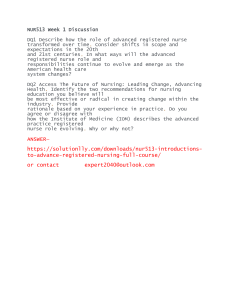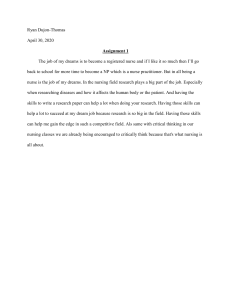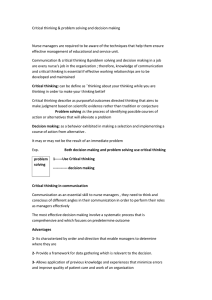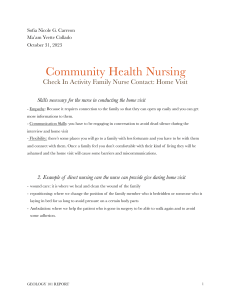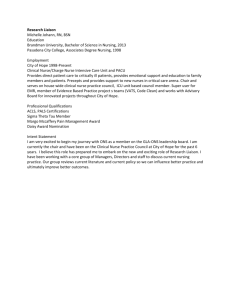Test Bank for Davis Advantage for Medical-Surgical Nursing Making Connections to Practice 2nd edition Hoffman Sullivan
advertisement
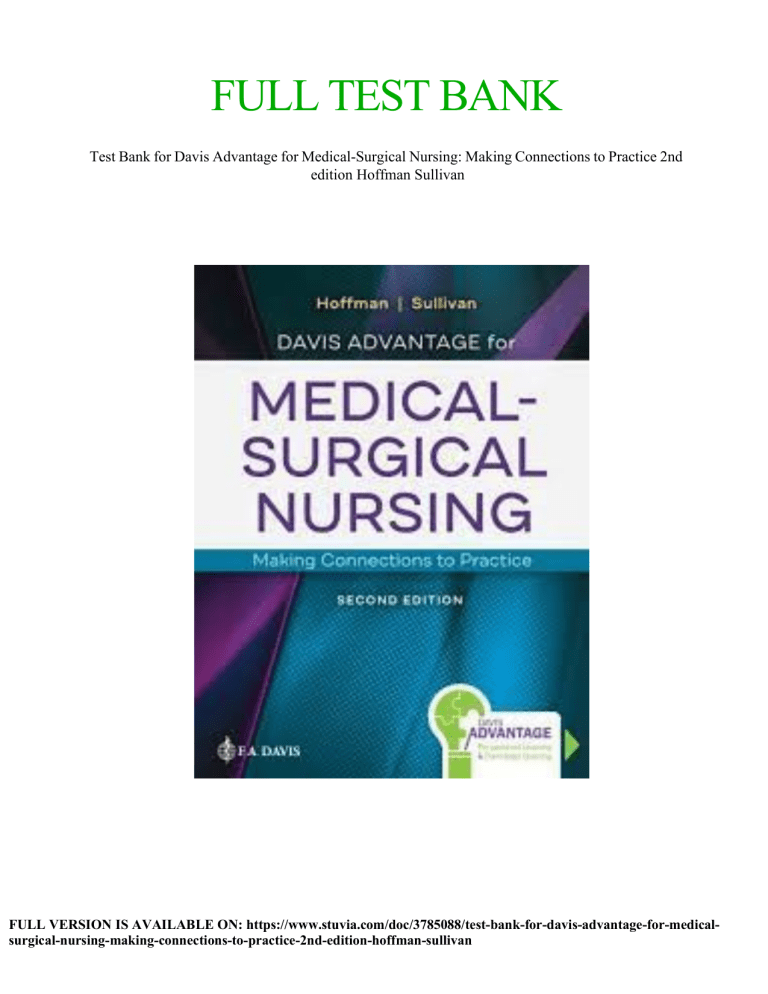
FULL TEST BANK Test Bank for Davis Advantage for Medical-Surgical Nursing: Making Connections to Practice 2nd edition Hoffman Sullivan FULL VERSION IS AVAILABLE ON: https://www.stuvia.com/doc/3785088/test-bank-for-davis-advantage-for-medicalsurgical-nursing-making-connections-to-practice-2nd-edition-hoffman-sullivan Thanks for the purchase best of luck champ Chapter 1: Foundations for Medical-Surgical Nursing Multiple Choice Identify the choice that best completes the statement or answers the question. 1. The medical-surgical nurse identifies a clinical practice issue and wants to determine if there is sufficient evidence to support a change in practice. Which type of study provides the strongest evidence to support a practice change? 1) Randomized control study 2) Quasi-experimental study 3) Case-control study 4) Cohort study 2. The medical-surgical unit recently implemented a patient-centered care model. Which action implemented by the nurse supports this model? 1) Evaluating care 2) Assessing needs 3) Diagnosing problems 4) Providing compassion 3. Which action should the nurse implement when providing patient care in order to support The Joint Commission’s (TJC) National Patient Safety Goals (NPSG)? 1) Silencing a cardiorespiratory monitor 2) Identifying each patient using one source 3) Determining patient safety issues upon admission 4) Decreasing the amount of pain medication administered 4. Which interprofessional role does the nurse often assume when providing patient care in an acute care setting? 1) Social worker 2) Client advocate 3) Care coordinator 4) Massage therapist 5. The medical-surgical nurse wants to determine if a policy change is needed for an identified clinical problem. Which is the first action the nurse should implement? 1) Developing a question 2) Disseminating the findings 3) Conducting a review of the literature 4) Evaluating outcomes of practice change FULL VERSION IS AVAILABLE ON: https://www.stuvia.com/doc/3785088/test-bank-for-davis-advantage-for-medicalsurgical-nursing-making-connections-to-practice-2nd-edition-hoffman-sullivan 6. The nurse is evaluating the level of evidence found during a recent review of the literature. Which evidence carries the lowest level of support for a practice change? 1) Level IV 2) Level V 3) Level VI 4) Level VII 7. The nurse is reviewing evidence from a quasi-experimental research study. Which level of evidence should the nurse identify for this research study? 1) Level I 2) Level II 3) Level III 4) Level IV 8. Which level of evidence should the nurse identify when reviewing evidence from a single descriptive research study? 1) Level IV 2) Level V 3) Level VI 4) Level VII 9. Which statement should the nurse make when communicating the “S” in the SBAR approach for effective communication? 1) “The patient presented to the emergency department at 0200 with lower left abdominal pain.” 2) “The patient rated the pain upon admission as a 9 on a 10-point numeric scale.” 3) “The patient has no significant issues in the medical history” 4) “The patient was given a prescribed opioid analgesic at 0300.” 10. The staff nurse is communicating with the change nurse about the change of status of the patient. The nurse would begin her communication with which statement if correctly using the SBAR format? 1) “The patient’s heartrate is 110.” 2) “I think this patient needs to be transferred to the critical care unit.” 3) “The patient is a 68-year-old male patient admitted last night.” 4) “The patient is complaining of chest pain.” 11. Which nursing action exemplifies the Quality and Safety Education for Nursing (QSEN) competency of safety? 1) Advocating for a patient who is experiencing pain 2) Considering the patient’s culture when planning care 3) Evaluating patient learning style prior to implementing discharge instructions 4) Assessing the right drug prior to administering a prescribed patient medication 12. Which type of nursing is the root of all other nursing practice areas? 1) Pediatric nursing 2) Geriatric nursing 3) Medical-surgical nursing 4) Mental health-psychiatric nursing 13. Which did the Nursing Executive Center of The Advisory Board identify as an academic-practice gap for new graduate nurses? 1) Patient advocacy 2) Patient education FULL VERSION IS AVAILABLE ON: https://www.stuvia.com/doc/3785088/test-bank-for-davis-advantage-for-medicalsurgical-nursing-making-connections-to-practice-2nd-edition-hoffman-sullivan 3) Disease pathophysiology 4) Therapeutic communication 14. Which statement regarding the use of the nursing process in clinical practice is accurate? 1) “The nursing process is closely related to clinical decision-making.” 2) “The nursing process is used by all members of the interprofessional team to plan care.” 3) “The nursing process has 4 basic steps: assessment, planning, implementation, evaluation.” 4) “The nursing process is being replaced by the implementation of evidence-based practice.” 15. Which is the basis of nursing care practices and protocols? 1) Assessment 2) Evaluation 3) Diagnosis 4) Research 16. Which is a common theme regarding patient dissatisfaction related to care provided in the hospital setting? 1) Space in hospital rooms 2) Medications received to treat pain 3) Time spent with the health-care team 4) Poor quality food received from dietary 17. The nurse manager is preparing a medical-surgical unit for The Joint Commission (TJC) visit With the nurse manager presenting staff education focusing on TJC benchmarks, which of the following topics would be most appropriate? 1) Implementation of evidence-based practice 2) Implementation of patient-centered care 3) Implementation of medical asepsis practices 4) Implementation of interprofessional care 18. Which aspect of patient-centered care should the nurse manager evaluate prior to The Joint Commission site visit for accreditation? 1) Visitation rights 2) Education level of staff 3) Fall prevention protocol 4) Infection control practices 19. The medical-surgical nurse is providing patient care. Which circumstance would necessitate the nurse verifying the patient’s identification using at least two sources? 1) Prior to delivering a meal tray 2) Prior to passive range of motion 3) Prior to medication administration 4) Prior to documenting in the medical record 20. The nurse is providing care to several patients on a medical-surgical unit. Which situation would necessitate the nurse to use SBAR during the hand-off process? 1) Wound care 2) Discharge to home 3) Transfer to radiology 4) Medication education Multiple Response FULL VERSION IS AVAILABLE ON: https://www.stuvia.com/doc/3785088/test-bank-for-davis-advantage-for-medicalsurgical-nursing-making-connections-to-practice-2nd-edition-hoffman-sullivan Identify one or more choices that best complete the statement or answer the question. 21. The staff nurse is teaching a group of student nurses the situations that necessitate hand-off communication. Which student responses indicate the need for further education related to this procedure? Select all that apply. 1) “A hand-off is required prior to administering a medication.” 2) “A hand-off is required during change of shift.” 3) “A hand-off is required for a patient is transferred to the surgical suite.” 4) “A hand-off is required whenever the nurse receives a new patient assignment.” 5) “A hand-off is required prior to family visitation.” 22. Which actions by the nurse enhance patient safety during medication administration? Select all that apply. 1) Answering the call bell while transporting medications for a different patient 2) Identifying the patient using two sources prior to administering the medication 3) Holding a medication if the patient’s diagnosis does not support its use 4) Administering the medication two hours after the scheduled time 5) Having another nurse verify the prescribed dose of insulin the patient is to receive 23. The medical-surgical nurse assumes care for a patient who is receiving continuous cardiopulmonary monitoring. Which actions by the nurse enhance safety for this patient? Select all that apply. 1) Silencing the alarm during family visitation 2) Assessing the alarm parameters at the start of the shift 3) Responding to the alarm in a timely fashion 4) Decreasing the alarm volume to enhance restful sleep 5) Adjusting alarm parameters based on specified practitioner prescription 24. The nurse is planning an i n t e r pr o f e sional careconferance for a patient who is approaching discharge from the hospital. Which members of the interprofessional team should the nurse invite to attend? Select all that apply. 1) Physician 2) Pharmacist 3) Unit secretary 4) Social worker 5) Home care aide 25. The nurse manager wants to designate a member of the nursing team as the care coordinator for a patient who will require significant care during the hospitalization. Which skills should this nurse possess in order to assume this role? Select all that apply. 1) Effective clinical reasoning 2) Effective communication skills 3) Effective infection control procedures 4) Effective documentation 5) Effective intravenous skills FULL VERSION IS AVAILABLE ON: https://www.stuvia.com/doc/3785088/test-bank-for-davis-advantage-for-medicalsurgical-nursing-making-connections-to-practice-2nd-edition-hoffman-sullivan
